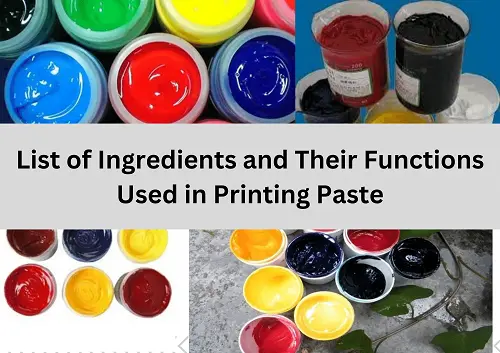List of Ingredients and Their Functions Used in Printing Paste in the Textile Industry
The process of printing involves uniformly adding color to cloth to create ornamental patterns. It is a step in the wet processing process, which comes after the cloth has been pretreated or dyed. It’s done to create visually appealing patterns on the cloth. Typically, the cloth is printed on one side alone. This article presents a List of Ingredients and Their Functions Used in Printing Paste in the Textile industry.
Textile printing and dyeing are comparable processes; however, with dyeing, one color is applied consistently across the garment. When printing, one or more colors are applied to the fabric in precisely defined patterns and only in certain areas. For this reason, printing is also known as localized dyeing.

List of ingredients used in printing paste:
- Dyestuffs and pigments
- Thickener
- Wetting agents
- Dispersing agents
- Swelling agents
- Carrier
- Antifoaming agents or de-foaming agents
- Oxidizing and reducing agents
- Catalyst or oxygen carrier
- Acid or alkali
Details of Ingredients and Their Functions Used in Printing Paste
Not one printing paste uses all of these ingredients at once. Appropriate ingredients are chosen to make the printing paste based on the type of dyestuff utilized and the printing technique employed. Their functions are stated below:
Dyestuffs and Pigments
Dyestuffs are chemicals that have chromophore and autochromes groups present in them, while pigments have only auxochromes groups. But their function is same; to create a required color effect on fabric. They have an attraction to the fiber due to the presence of an autochrome group. To produce the required shade is the primary function of dyestuff. Examples: VAT, Reactive dye, Azo, Direct dye, etc.
Thickener
Thickener is a high molecular weight polymeric substance that gives the required viscosity to the printing paste. These impart stickiness and plasticity to the printing paste; thus, the design outlines are properly maintained. Holding the components of printing paste on the cloth in the desired place is its primary purpose. It creates a strong bond with fiber and pigments, thus enhancing the durability of the printed pattern. Examples: Sodium alginate, CMC, British gum, etc.
Wetting Agents
The main goal of wetting agents is to lower the surface tension of water. This substance guarantees that water and dyestuff are distributed uniformly across the fabric’s surface. Additionally, it makes it easier for dyestuff to seep into the fabric. Dissolving the dyestuff also guarantees the development of a smooth printing paste. Examples: TR Oil, olive oil, castor oil, Lissapol-N, etc.
Dispersing Agents
The main function of the dispersing agent is to evenly distribute dye molecules in the paste. In order to stop color molecules from clumping together in the extremely concentrated dye it is another function of the dispersing agent. It assists dye penetration as well as dye fixation. It also increases the solubility of dye. Getting bright designs and proper printing shade while printing with VAT dyes is another function of the dispersing agent. Examples: Diethylene glycol, acetin, urea, glycerine, etc.
Swelling Agents
These chemicals are used mainly in polyester printing. Polyester has a distinct structure, making it more difficult for dye molecules to pass through. Swelling agents reduce the crystallinity of fiber and create big size holes in it. It helps to swell the fiber structure to enable dyes or pigments to enter the fiber molecule and stuck there permanently. Examples: Polyethylene glycol, Phenol, etc.
Carrier
Used for fixing dispersed dyes on polyester fibers at temperatures below 105º C. These accelerate the rate of dye penetration. Examples: Diphenol, Orthophenol, etc.
Antifoaming Agents or De-foaming Agents
During the printing process, printing paste is handled by numerous machinery, which creates foam in the paste due to continuous shaking. Printing is uneven and challenging when foam is present. De-foaming agents prevent foam formation during printing. Example: Silicone defoamers, Sulfide oil (T.R Oil)
Oxidizing Agents
Oxidizing agents help in color fixation by assisting in the development of the final color during steaming or the next treatment. They are mainly used in the case of printing with VAT, azo, aniline black dye, etc. If oxidizing agents are used in printing paste, they should not be active since this could cause premature color development. While using azo dyes, partial color can be destroyed by the action of reduction. Mild oxidizing agents can secure this situation. Examples: Sodium chlorate, Resist salt, Ludigol, Potassium chlorate, Sodium nitrite, etc.
Reducing Agents
Reducing agents helps in the reduction of different dyes. It destroys the color from the ground of the fabric. Extensively used in the vatting process in the case of vat dyes. It is also used in printing with dispersed dyes. Examples: Rongolite-C, Sodium hydro-sulfite, Stannous chloride, etc.
Catalyst or Oxygen Carrier
In printing paste, where steaming is essential, catalysts are utilized. They guard against damaging fibers during steaming at elevated temperatures. They speed up the final color development by oxidation. Examples: Potassium ferrocyanide, Copper sulfide, etc.
Acids and Alkalies
Acids are utilized while developing and fixing color in printed material using particular dyes. In order to create printing paste, acid-liberating agents are preferable instead of direct acids. In some instances when printing paste creation occurs, strong to medium strength alkalis are also employed. One of the primary functions of acid and alkali is to maintain the pH of printing paste. Examples: Organic acid, NaOH, KOH, Sodium bicarbonate, Potassium carbonate, etc.
It is very important to know the List of Ingredients and Their Functions Used in Printing Paste if you are related to the Textile industry. The mixture solution is also vital for a perfect printing process on fabric.
- References: Technology of textile processing by Dr. V.A. Shenai
- https://textileapex.com/basic-ingredients-of-printing/
- https://www.slideshare.net/ChiragBansal41/printing-ingredients
- Written by: Mahzabin Mosharrof
- Instructor, National Institute of Engineering and Technology, Dhaka.
- Email: [email protected]
- You may love to read: Types of Screen Printing, and Its Use
- Block Printing in Textile Industry: Types, Methods, and Advantages
- Common Printing Defects in Fabric | Causes and Remedies
- Digital Printing on Fabric: Digital Printing Process Step By Step


